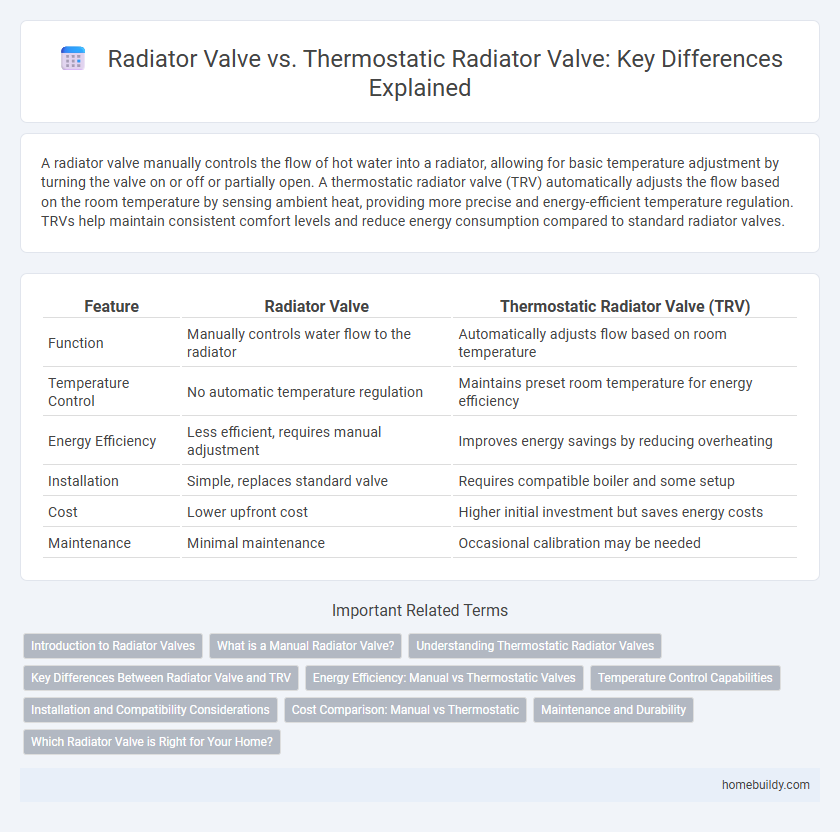A radiator valve manually controls the flow of hot water into a radiator, allowing for basic temperature adjustment by turning the valve on or off or partially open. A thermostatic radiator valve (TRV) automatically adjusts the flow based on the room temperature by sensing ambient heat, providing more precise and energy-efficient temperature regulation. TRVs help maintain consistent comfort levels and reduce energy consumption compared to standard radiator valves.
Table of Comparison
| Feature | Radiator Valve | Thermostatic Radiator Valve (TRV) |
|---|---|---|
| Function | Manually controls water flow to the radiator | Automatically adjusts flow based on room temperature |
| Temperature Control | No automatic temperature regulation | Maintains preset room temperature for energy efficiency |
| Energy Efficiency | Less efficient, requires manual adjustment | Improves energy savings by reducing overheating |
| Installation | Simple, replaces standard valve | Requires compatible boiler and some setup |
| Cost | Lower upfront cost | Higher initial investment but saves energy costs |
| Maintenance | Minimal maintenance | Occasional calibration may be needed |
Introduction to Radiator Valves
Radiator valves control the flow of hot water into radiators, regulating room temperature and improving heating efficiency. Traditional radiator valves require manual adjustment, while thermostatic radiator valves (TRVs) automatically adjust the flow based on room temperature, providing precise climate control and energy savings. Selecting the appropriate valve type enhances comfort and reduces heating costs in residential and commercial heating systems.
What is a Manual Radiator Valve?
A manual radiator valve controls the flow of hot water in a radiator through a simple mechanical dial or lever, allowing users to adjust heat output manually. Unlike thermostatic radiator valves (TRVs), manual valves lack temperature sensors and do not automatically regulate room temperature based on preset levels. This basic valve type offers straightforward on/off or gradual flow control but requires user intervention to maintain desired comfort.
Understanding Thermostatic Radiator Valves
Thermostatic Radiator Valves (TRVs) offer precise temperature control by automatically adjusting the flow of hot water based on room temperature, unlike traditional radiator valves that require manual adjustment. TRVs contain a sensor that expands or contracts with temperature changes, regulating heat output efficiently to maintain consistent comfort levels. This smart functionality improves energy efficiency and reduces heating costs by preventing overheating and unnecessary energy use in individual rooms.
Key Differences Between Radiator Valve and TRV
Radiator valves manually control hot water flow into radiators, allowing basic temperature adjustment, while thermostatic radiator valves (TRVs) automatically regulate room temperature by sensing ambient heat and adjusting flow accordingly. TRVs provide energy efficiency by reducing overheating and maintaining consistent comfort, whereas standard radiator valves require manual intervention. The key differences lie in automation, energy savings, and precise temperature control capabilities.
Energy Efficiency: Manual vs Thermostatic Valves
Manual radiator valves require constant adjustment to regulate temperature, often leading to energy waste and higher heating bills. Thermostatic radiator valves (TRVs) automatically adjust heat output based on room temperature, optimizing energy use and enhancing overall heating efficiency. Studies show TRVs can reduce energy consumption by up to 20% compared to manual valves, making them a cost-effective solution for temperature control.
Temperature Control Capabilities
Radiator valves offer basic on/off control by regulating water flow manually, resulting in less precise temperature management. Thermostatic radiator valves (TRVs) integrate sensors to automatically adjust flow based on room temperature, delivering more consistent and energy-efficient heating. These advanced valves optimize comfort by maintaining desired temperatures and reducing energy waste.
Installation and Compatibility Considerations
Radiator valves typically require straightforward installation compatible with standard pipe sizes, while thermostatic radiator valves (TRVs) demand precise positioning to allow their temperature sensors to accurately detect room heat. Compatibility with existing radiator and pipework types is critical; standard valves fit most traditional radiator systems, whereas TRVs need sufficient space for sensor heads and may require adapters for certain valve bodies. Proper installation of TRVs enhances energy efficiency by regulating heat output automatically, but both valve types must align with the radiator's threading and system pressure specifications for optimal performance.
Cost Comparison: Manual vs Thermostatic
Manual radiator valves generally cost less upfront, ranging between $10 and $30 per valve, while thermostatic radiator valves (TRVs) typically range from $40 to $70. Although TRVs have a higher initial price, they offer energy savings by automatically regulating room temperature, potentially reducing heating bills by up to 15%. The long-term cost-effectiveness of TRVs often outweighs the lower initial investment of manual valves due to improved energy efficiency and comfort control.
Maintenance and Durability
Radiator valves require regular manual adjustments and occasional lubrication to maintain efficient operation, with basic models often needing replacement every few years due to wear and tear. Thermostatic radiator valves (TRVs) feature built-in temperature sensors that regulate flow automatically, reducing the frequency of manual maintenance and generally offering longer durability thanks to their advanced design. Proper maintenance of both valve types extends their lifespan, but TRVs typically provide improved energy efficiency and reliability over standard radiator valves.
Which Radiator Valve is Right for Your Home?
Choosing the right radiator valve depends on your home's heating needs and desired energy efficiency. Traditional radiator valves control water flow manually, offering simple on/off functionality, while thermostatic radiator valves (TRVs) automatically adjust heat output based on room temperature for improved comfort and energy savings. TRVs are ideal for homes seeking precise temperature control and reduced energy bills, whereas manual valves suit spaces with straightforward heating schedules.
Radiator Valve vs Thermostatic Radiator Valve Infographic

 homebuildy.com
homebuildy.com